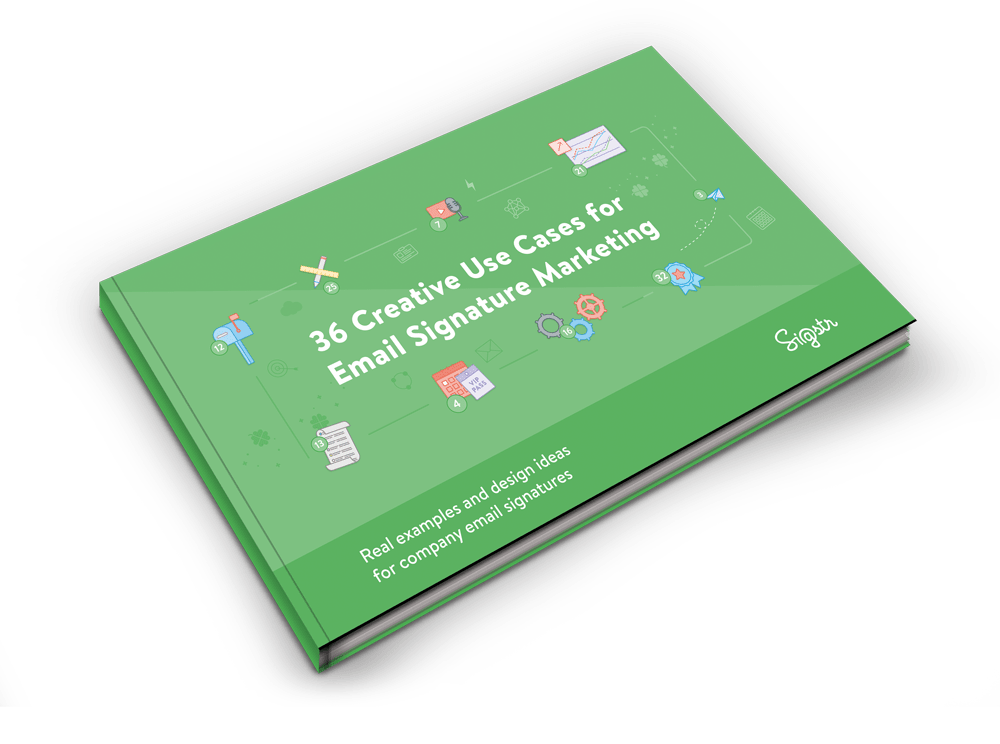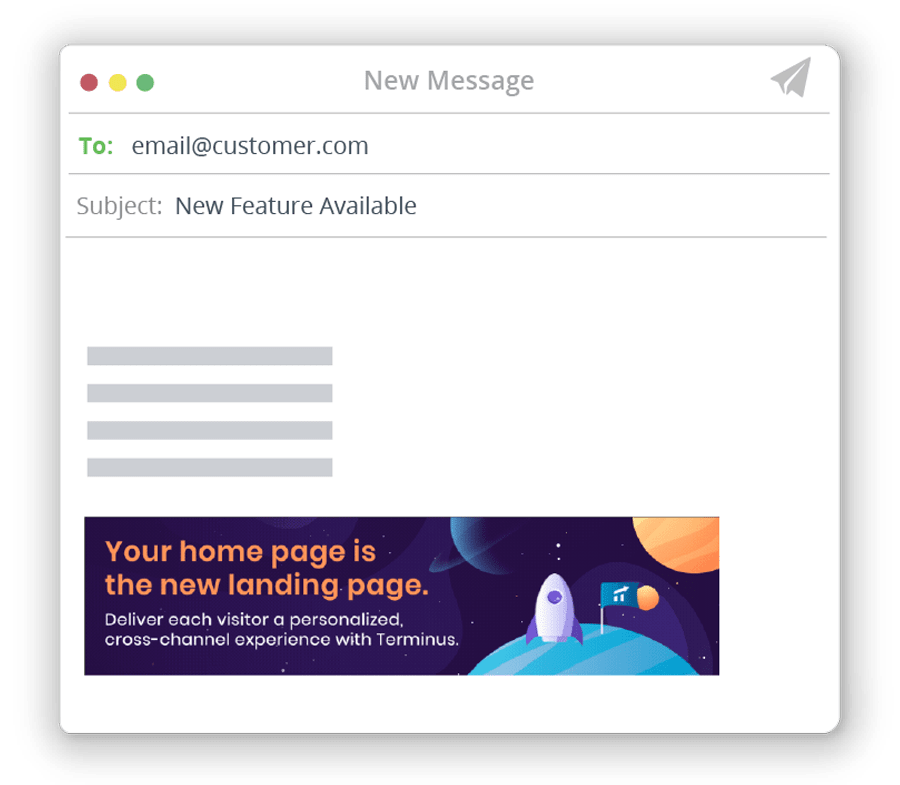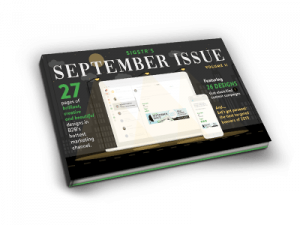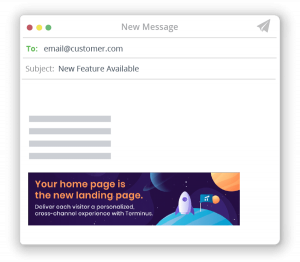Email Format Examples: Branded Email Signatures and Banners
The email signature is the most important element of an email format. See how Terminus can help standardize your company email signature across all employees – request a demo today or check out 36 different customer examples.


The Elements of an Effective Prospecting Email Format With Terminus Email
The average employee sends over 10,000 emails every year. Adding Terminus Email to the email signature of your employee’s Gmail or Outlook opens up one of the most effective and efficient marketing channels out there.

[Ebook] The Total Marketing Impact of Professional Employee Email
Read it now
Terminus September Issue: The Best Email Banner & Digital Ad Designs
learn more
[Blog] 6 Examples of Using Employee Email as a New Marketing Channel
See more examplesEmail Format
Every day, thousands of people ask themselves, “what is the correct email format?” But in reality, there is no one right way to create an email format. It instead takes lots of practice and repetition based off who you are sending the email to. If you follow a few simple guidelines for your email format and then add your own style and creativity, you will have the perfect email designed just for you and your readers. A basic email letter format consists of:
- A subject line that gets the reader’s attention
- Greetings
- Content (try to keep it brief, but also include everything that is necessary)
- Closing Email signature
- Email banner (located underneath the email signature)
Email template examples can also help you get a sense of what each section should and shouldn’t include. If these tips above don’t give you everything you need, there is an email format template or email writing format pdf you can download and use to help. The basic email format will help guide you with how to structure your email, as each type of email has its own personal format. For example, all emails should be created with the basic email layout, but a request email format should have the content section written with background on the topic accompanied by the actual request. Jumping straight into a request may work in specific situations, but adding politeness with your greetings and content builds goodwill for your reader. Additionally, the email format for students will be written with more politeness and formal guidelines as the student is writing to his or her professor or teacher. No matter who you are writing to and what it concerns, the basic english email format will help you start your email with the correct structure. Every email you send is different, but this format above helps provide a starting point so you can compose an email quicker and with more professionalism.
What’s the first step most companies take when onboarding a new employee? Apart from the paperwork, it’s creating an employee email account. Email is critical to the way most businesses today operate. And email format can vary depending on whether it’s a Gmail account or Outlook email.
Every employee gets their own email login. Once you enter your email address, you’re representing the company — not just yourself. The first thing you’ll need to know is how to set email signatures. Employees can ask IT departments about how to enter email accounts, how to enter my email address, or how to enter email or phone number to find contacts. But what employees can’t ask IT departments about is how to create the proper email format, signature, and design.
Once you enter email accounts or enter email password information, you have free rein over how you design your emails. A professional email design will be the first experience many customers have with you.
To make sure that your email is accessible, first look into how to set up email on phone and how to setup email on computer. Your internal IT department should be able to tell you how to setup email on Android phone and iPhone environments. You should be able to connect to your email account from anywhere. A free email account may have limitations on the size of emails you can send and receive. When you create email account logins, make sure you do so with secure passwords.
Many companies have a company email address format, which will guide how to write email address names. For instance, some companies use initials such as [email protected], whereas others use full names such as [email protected] Still others use positions only, such as [email protected] Once you know the company email address format, then you can look into how to write email address format and signatures.
Before you compose your first email, you should understand the enter email address meaning when it comes to formatting and polish. Emails carry with them many of the same conceits as writing a letter; you want to acknowledge the person, skip quickly to the body text, and then sign off with a clear call-to-action. When you write a professional email properly, the individual will know exactly what they should do next, and how to connect with you for more information.
Email Format Professional
A professional email format differs from an academic, business, or formal email format. Let’s explore how you create an email format professional, with the following professional email example:
Hi Thomas,
I’m David, head of sales for ABC Corporation. I’m interested in connecting with you regarding your account. I’m really excited to share a few promotions with you that are expiring next week.
Let me know when would be a good time to connect.
All the best,
David
There are some important things to note about this professional email. A professional email isn’t a formal email; it’s a business-related email. Today, professional emails need to be personalized and polished, but they’re also a little more casual. They tend to be customized per customer. when you look at professional email writing examples PDF documents, they’re short and sweet. The email format template shouldn’t go longer than a page.
In the above professional email format example, you can see that David directs what the individual should do immediately upon receipt of the email; let them know when would be a good time to connect. A professional email example is going to be direct and to the point, it’s going to tell people what to do next, and it’s going to be friendly and almost casual.
This differs from an email example for something like academia, which tends to be more formal. When you look into how to write an email for business, you’re usually writing something that is promotional in nature. While it doesn’t have to be “salesy,” it usually has to do with either customer service or marketing.
When looking into how to write an email, you do need to consider the type of email and the recipient. An academic email to a professor or even to a colleague may need to be longer and more explicit than an email that is going to a business contact, sales contact, or even a vendor. When it comes to professional emails, short, snappy, and clear is the general rule. The less there is up to chance, the better.
Most people today communicate via email. It’s very important to make sure that emails are as clear as possible. But it’s also important to be relatable and interesting.
Email Format Formal
Let’s consider now a formal email format. Let’s take a look at the general email format formal:
To My Congressional Representative,
I am writing to you as a concerned citizen of District 34. I am concerned about the recent passing of Policy No. 2948, which would significantly disrupt the green spaces within my neighborhood. I, and many others I know, would prefer to retain those green spaces — and instead make use of the dilapidated commercial districts at the fringes of the town.
We would love to discuss this with you at the next town meeting.
Warmest regards,
David Smith
As you can see, a formal email is a little more “academic” in nature. A formal email is distinct in tone. When you look into how to write a formal email, you first need to look at formal email greetings. A business email is going to start with a first name frequently, to ingratiate yourself to the individual. Formal email greetings will include the individual’s full name and title. That’s just one of the ways in which formal emails differ from general business emails.
In formal email writing examples, you will still get to the point quickly. But you may provide more information. An email format letter is going to go into further detail when it’s formal; the goal is more to write a letter than an email. A hybrid email letter format essentially assumes you won’t be going through a quick back-and-forth with the individual, but rather that your email will be read and seriously considered.
The easiest way to understand the differences is to look at many formal email format example sites. Proper email format can vary depending on the circumstance, industry, and even receiving individual. Likewise, how to write an email example letters are going to vary depending on country and culture. Enter email Hindi meaning and email English meaning into Google and you will get vastly different results.
Apart from this, it’s important to know when you would be sending a formal email vs. a business email vs. an academic email. For instance, an email to a professor will probably be a combination of formal and academic, while an email to a fellow student might just be academic. An email to a colleague will be a business email, but an email to a boss might be a formal business email. These distinctions can be gray and are largely cultural; even company culture can impact the formality level of your writing.
Business Formal Email
Apart from a business email format and a formal email format, there’s also the business formal email. These are business emails that need to be more formal, such as a first email to a colleague or a supervisor. Let’s take a look at a business email format example that’s very common: a hiring email. This business email example is essentially a cover letter.
To whom it may concern,
I’m writing to show my interest in the position of ad copywriter for XYZ Corporation. In my tenure at ABC, I handled over two dozen accounts and a combined $300,000 in advertising spend. My advertising campaigns were able to generate a consistent ROI of over 304% annually — and my customer retention rates were over 80%.
Please let me know if you have any further questions,
Best regards,
John Smith
A business formal email carries with it many of the hallmarks of a traditional formal email. It follows a strict company email format or employee email format; it begins with a formal title and ends with a formal sign-off. Good email examples will get directly to the point, but will still have enough detail that ideally, the recipient shouldn’t need another follow-up. The above email format example further includes specific numbers, rather than vague statements.
The best way to understand email format is to look up as many email writing samples as possible. Email writing samples are what tell you what’s expected depending on industry, size of company, and the actual circumstances of the email. You can look up “customer emails” “emails to colleagues” or “notification email format.” There are highly specific templates that you can use.
There are also programs that you can feed your email into that will detect tone. It will detect whether your writing is formal or informal. This isn’t always applicable, as many formal writing generators avoid contractions (“cannot” instead of “can’t”), which isn’t strictly used in formal emails today.
Regardless, the important part of a formal email is that the person who receives the email understands what you’re trying to say and reacts positively to its tone.
Email Example
Examples of emails can range depending on the main focus of the email. A sample email for request document follows a typical request email template, while an email showing interest in an open position is based off of what the sender knows about the job. No matter what you are writing for, following the email format given above is the first and best step to follow. At the same time, we also know showing is more effective sometimes than just talking about it. So, we wanted to help by providing a few different samples of a formal email example below.
Formal Email Example:
Hello Sir,
My name is Sean Sigstr and I am contacting you about the Sales position available from your LinkedIn post. I am very interested in this position as I believe my qualifications position me as an excellent candidate. Attached is my resume to show my past experience. I believe my qualifications of.
Look forward to hearing from you soon.
Thanks in advance,
Formal Email of Request for Documents:
Hi Sir,
We have noticed we do not have a copy of your updated contract from last week on file. Will you please send over a scan of your updated contract? Please send it to us by next Wednesday, or before the end of the quarter.
Thanks in advance,
Analyze email examples not just for the writing style, but also for the format of the email. These brief emails above give you an idea of how to approach and finish an email, but the content within can change from time to time. For example, the template for an email requesting documents can vary from a greeting email template. Luckily there are various online tools to give an email format example, such as the examples above. We hope our email format sample above gave you more of an idea of how to start your email.
Business Email Example
Writing a business formal email is similar to writing just a formal email, but often times it’s shorter in length and more to the point. All of us are busy, and most likely have dozens of unread emails in our inboxes, so keeping the email short and sweet will benefit everyone. A business email example follows the structure of any email, with a greeting, introduction of why you are sending the email, the content, a closing, an email signature, and ad banner below the email signature. There are multiple resources that show professional email writing examples, with tips on when to be lengthy and when to get straight to the point. For example, if you unfortunately had to let someone go at your company, you wouldn’t jump straight to the point in the opening sentence. Instead, you would explain why this is happening, tell them the hard news, and be empathetic. The business email format template adjusts slightly when it depends on what you are writing about and to who. Informing the company on some bad news will have a different format than when you are telling them great news. Each situation comes with a different approach. As mentioned above, there are several tools available online, such as a business email writing samples pdf or professional email templates for business, that will guide you through the journey of email writing. There are many versions of a business email format sample you can use, each one catering to different email writing situations.
To give you a real example of a business email, here is a sample email to client for business:
Dear Sean,
It was great seeing you and catching up this past weekend at the conference! I loved hearing about the advancements of your company and how you brought in nearly 1,000 customers this past year. Kudos to you! Like I mentioned this weekend, Sigstr would love to chat with you and your company about how we can work together.
An email to a client should start with a warm greeting, occasionally followed by small talk (as you can see in the sample above). It can then be followed by recognition of their company to show your interest, followed by a proposed next step or call-to-action. Adding a few touches that show you are investing in a business relationship can go a long way. We hope our business email format example and tips above will benefit you with your business email writing skills.
Email Writing Samples
We ask several questions every time we write an email: How do I start? How should I write? How much should I write? How do I end? Multiple email writing samples give you the do’s and don’ts for writing emails, as well as email writing format in english grammar to help you get a better understanding on how to write. Whether you are writing a business email to a client or a personal email to a long time friend, the format of email writing in english usually stays the same. With a few tweaks to the length and professionalism of each section of the format, the structure of an email will be the same. With the basic structure of an email being the greeting, body, closing, email signature, and banner, the format can slightly change depending on the recipient. For example, the email writing format for students to professors may vary from the format for a CEO writing to his or her entire company. If you are still confused on what format to use for your email, you should look into an email writing examples pdf, as it includes all kinds of examples. From simple email writing examples, to email writing examples for students, and even a letter writing format for students, these types of resources can provide a lot of value.
All of these email writing format samples will help you in your first step of writing your email. The hardest part of writing an email is deciphering what format to use and how to write to the reader. We at Sigstr write hundreds of emails a day, and most of us get stuck on this first step as well. As soon as we decide the format and how to write, everything else flows naturally. We hope our advice will help you speed up your email writing process.
How to Write Email Address
You may be wondering: what is an email address? Give an example to us? An email address is an identifier for a specific sender to receive a message through email, like a phone number. There are hundreds of email addresses created daily, and we are here to help you create one! Before we start, it’s important to learn how to write email address options.
Can it include capital letters? Symbols? What’s a professional email address? Does the domain matter? For starters, all email addresses can include capitalized and uncapitalized letters, as well as all numbers. Unfortunately, the only symbols one can use in an email address are hyphens ( – ), underscores ( _ ), periods (.), and the required at symbol (@). Additionally, there are 3 parts of an email address: the username, the @ symbol, and the domain. Your username is your chance to be unique by using your name, nickname, or whatever you feel is comfortable. If you are creating a professional email address, it is best to use your name to show professionalism (instead of a nickname like “sigstrgal1234”). The domain of an email address is split into two sections: the server of the email, such as Gmail, Yahoo, or a company’s name, and the extension, such as .net, .com, ,org, etc. Putting these three parts together creates a valid email address. There are online resources with tools such as an email address example list and a guide on how to make an email address. We hope these tips help with your questions on how to make a valid email address. Once you create your email address with you preferred domain, you are able to send thousands of emails with just a click of a button. Take advantage of this method of communication, as it is utilized daily in both the business and personal world.



